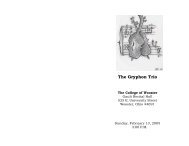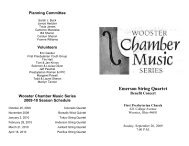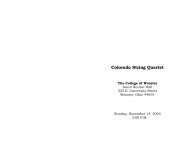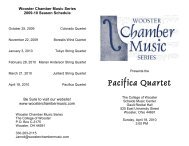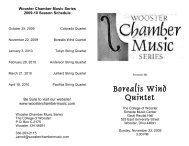Gryphon Trio - Wooster Chamber Music Series
Gryphon Trio - Wooster Chamber Music Series
Gryphon Trio - Wooster Chamber Music Series
You also want an ePaper? Increase the reach of your titles
YUMPU automatically turns print PDFs into web optimized ePapers that Google loves.
harmony lost in the trees. Transposing that to a religious level, you have<br />
the harmonious silence of heaven. The piano plays a rhythmic ostinato<br />
based on three Hindu rhythms; the clarinet spins out a bird song.<br />
II. Vocalise, for the Angel Announcing the End of Time: The first and<br />
third parts evoke the power of this strong angel, crowned with a rainbow<br />
and clothed in clouds, one foot on the sea and the other on land. The<br />
central section deals with the impalpable harmonies of heaven, the piano<br />
playing soft cascades of chords: blue and mauve, gold and green, redviolet,<br />
blue-orange; all of this dominated by steel-grey. These chords<br />
surround the plainchant-like melody of the violin and cello.<br />
III. The Abyss of the Birds: Clarinet solo. The abyss is time, in its<br />
sorrows and lassitudes. The birds offer a contrast, symbolizing our<br />
yearning for light, stars, rainbows and jubilant voices. The piece begins<br />
in sadness. Notice the long tones: pianissimo, crescendo molto to the<br />
most atrocious fortissimo. The bird-songs are written in the gay and<br />
fanciful style of the blackbird. The return to desolation is manifested in<br />
the dark timbre of the clarinet's lower register.<br />
IV. Interlude: Scherzo. Of a more outgoing character than the other<br />
movements, but related to them by various melodic references.<br />
V. Praise to the Eternity of Jesus: Jesus represents, in this context,<br />
the word of God. One long, extremely slow phrase by the cello glorifies<br />
with tenderness and reverence the eternity of this powerful and gentle<br />
Word. Majestically the melody unfolds like a distant memory, tender and<br />
all encompassing. "In the beginning was the Word, and the Word was<br />
with God, and the Word was God."<br />
VI. Dance of Wrath, for the Seven Trumpets: Rhythmically the most<br />
idiosyncratic movement of the set. The four instruments in unison give<br />
the effect of gongs and trumpets (the first six trumpets of the Apocalypse<br />
attend various catastrophes; the trumpet of the seventh angel announces<br />
the consummation of the mystery of God). <strong>Music</strong> of stone, formidable<br />
sonority; movement as irresistible as steel, as huge blocks of livid fury or<br />
ice-like frenzy. Listen particularly, toward the end of the piece, to the<br />
terrifying fortissimo of the theme in augmentation and with change of<br />
register of its different notes.<br />
VII. Tangle of Rainbows, for the Angel Announcing the End of Time:<br />
This movement is dedicated to the angel, and even more so, to the<br />
rainbow covering him (a rainbow symbolizing peace, wisdom, and all<br />
luminous and resonant vibration). In my coloured dreams I hear and see<br />
ordered melodies and chords, familiar hues and forms; then, following<br />
this transitory stage I pass into the unreal and submit ecstatically to a<br />
vortex, a dizzying interpenetration of superhuman sounds and colours.<br />
These fiery swords, these rivers of blue-orange lava, these sudden stars:<br />
Behold the cluster, behold the rainbows!<br />
VIII. In Praise of the Immortality of Jesus: Abroad violin solo,<br />
balancing the cello solo of the fifth movement. Why this second tribute?<br />
It addresses more specifically the second aspect of Jesus –the man, the<br />
Word made flesh, raised from the dead and immortalized to make His life<br />
known to us. This movement is pure love. It ascends gradually toward an<br />
intense peak, the ascension of man towards God, of the Son of God<br />
toward his Father, of the creature become divine towards paradise.<br />
--- Brian Biddle<br />
<strong>Gryphon</strong> <strong>Trio</strong><br />
With James Campbell, Clarinet<br />
Annalee Patipatanakoon, violin; Roman Borys, cellist; Jamie Parker, piano<br />
The <strong>Gryphon</strong> <strong>Trio</strong> is one of North America’s finest chamber ensembles.<br />
Since their founding in 1993, they have appeared throughout Canada,<br />
the United States, and Europe, delighting critics and audiences with<br />
exhilarating, and sometimes unusual, performances.<br />
The <strong>Gryphon</strong> <strong>Trio</strong> is highly versatile, both in repertoire and in the<br />
venues where they have played, enabling them to reach new and younger<br />
audiences. In addition to works by such established composers as<br />
Haydn, Mozart, Beethoven, Schubert, Mendelssohn, Dvorak, and<br />
Shostakovich, the group has actively expanded the piano trio repertoire<br />
with pieces by numerous contemporary composers. They have<br />
commissioned and premiered more than 50 works by composers who<br />
include Christos Hatzis, Chan Ka-Nin, Gary Kulesha, and others. They<br />
have expanded the reach of chamber music in varied collaborations,<br />
such as those with clarinetist James Campbell (who appears with them<br />
today), actor Colin Fox, choreographer David Earle, and many wellknown<br />
jazz artists at Toronto’s Lula Lounge. Their Constantinople is a<br />
groundbreaking multidisciplinary production, composed by Hatzis, which<br />
integrates instrumental, visual, theatrical, and vocal art into a socially<br />
poignant exploration of the human spirit.<br />
The most recent of the <strong>Gryphon</strong>’s ten recordings is Tango Nuevo,<br />
with music by Astor Piazzolla and Hilario Duran. The group won a<br />
coveted Juno Award (in Canada) in 2004 for their Canadian Premieres,<br />
featuring the works of leading Canadian composers. The <strong>Gryphon</strong> <strong>Trio</strong><br />
are Artists-in-Residence at the University of Toronto. In addition to<br />
teaching and performing at the University, they give frequent master<br />
classes and presentations at schools and universities across the<br />
continent, and have presented lecture-demonstrations with composer<br />
Gary Kulesha and music commentator Rob Kapilow, through <strong>Music</strong><br />
TORONTO. They are Artistic Programming Directors of the Ottawa<br />
International <strong>Chamber</strong> <strong>Music</strong> Festival, having already established<br />
themselves as beloved performers at this and many other chamber music<br />
festivals.<br />
Clarinetist James Campbell has performed in major concert halls<br />
throughout the world. He has appeared with over fifty orchestras,<br />
including the London Symphony, the Russian Philharmonic, the<br />
Edmonton Symphony Orchestra, and the Boston Pops. He has<br />
collaborated with more than thirty renowned string quartets, such as the<br />
Amadeus, the Guarneri, the Vermeer, and the Allegri String Quartets.<br />
Mr. Campbell has performed with musical luminaries that include both<br />
Aaron Copland and Glenn Gould. He has recorded extensively, with over<br />
forty recordings so far, including his Juno Award-winning Stolen Gems.<br />
Other noted releases include the Brahms Clarinet Quintet, with the<br />
Allegri Quartet, which was voted “Top Choice” by BBC Radio 3; and the<br />
Sony Classical re-release of Debussy’s Premier Rhapsody with pianist<br />
Glenn Gould. (Those familiar with the Internet can visit YouTube.com, do<br />
a quick search, and view delightful footage from the Campbell/Gould<br />
Debussy performance.) Since 1984, Mr. Campbell has been Artistic



